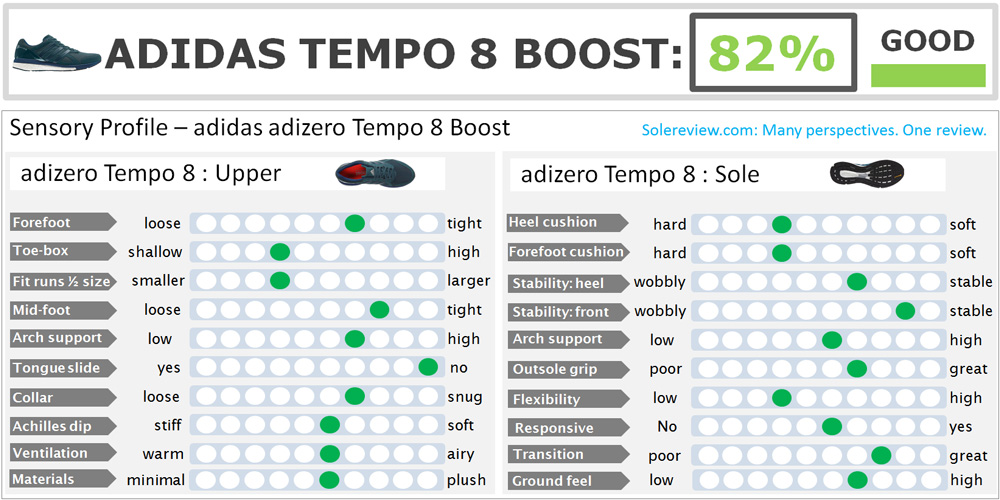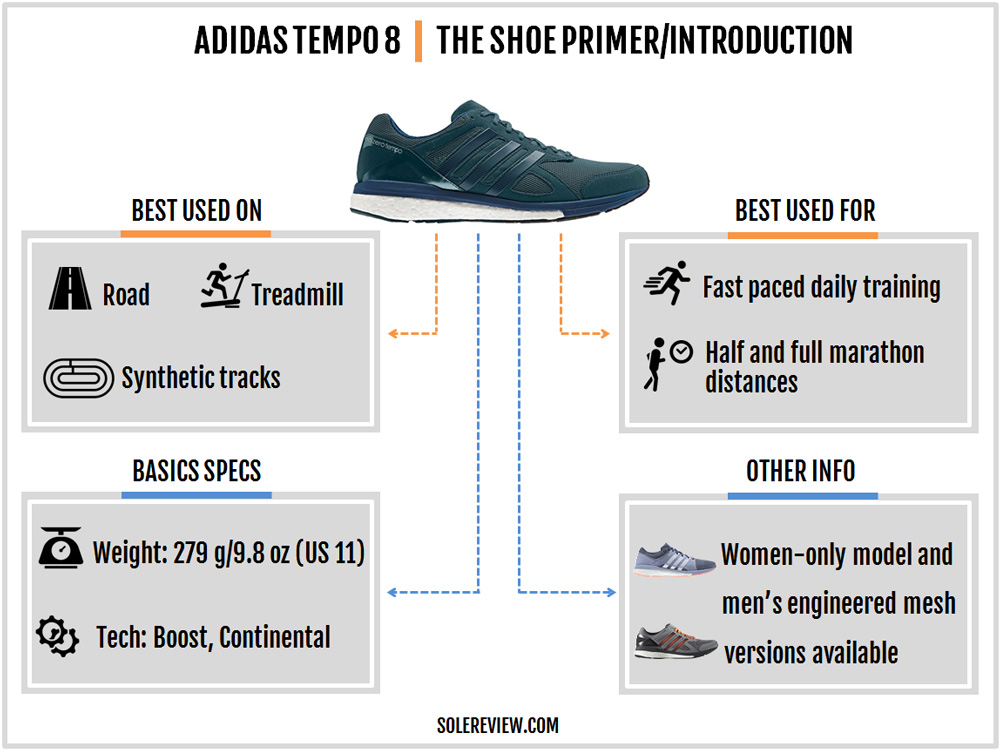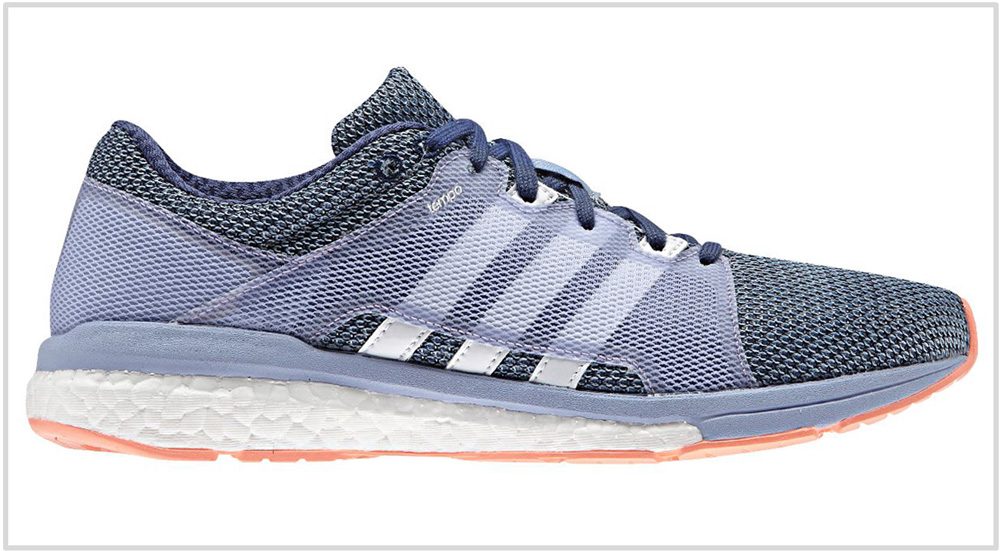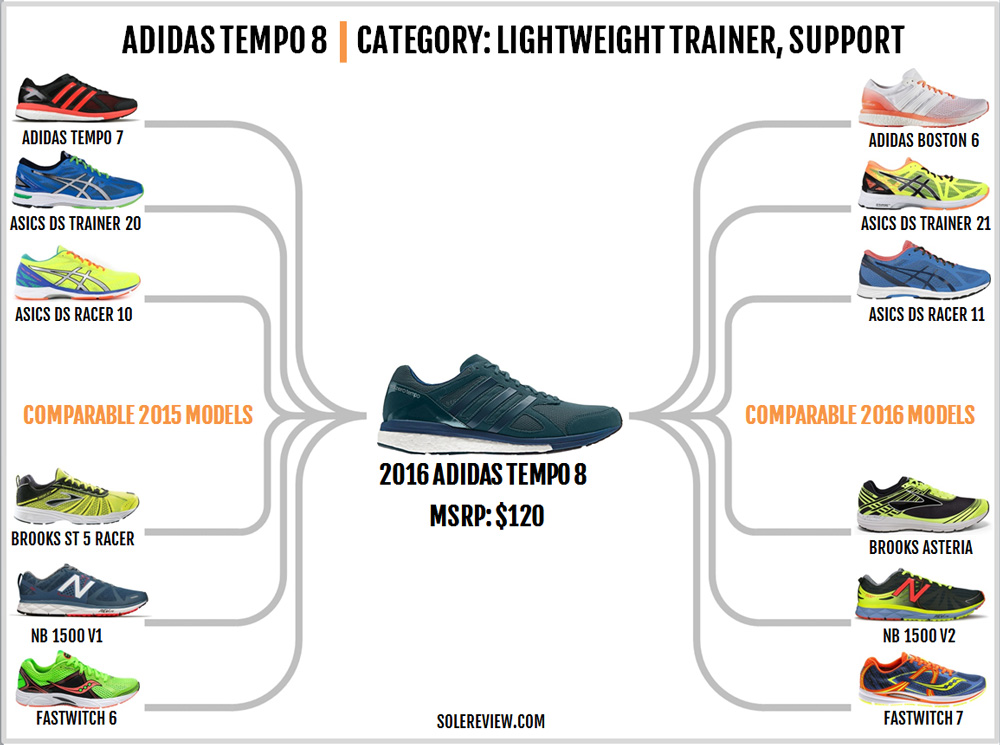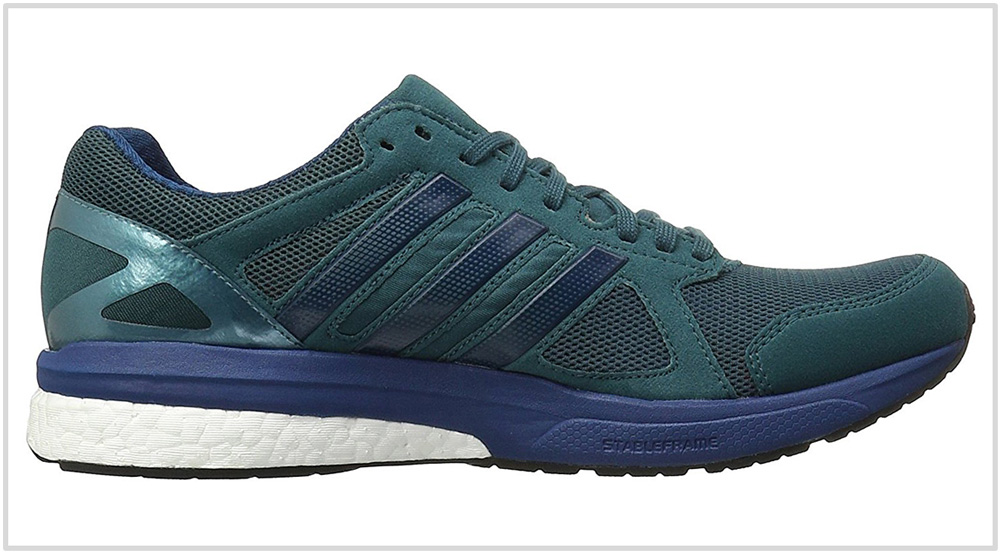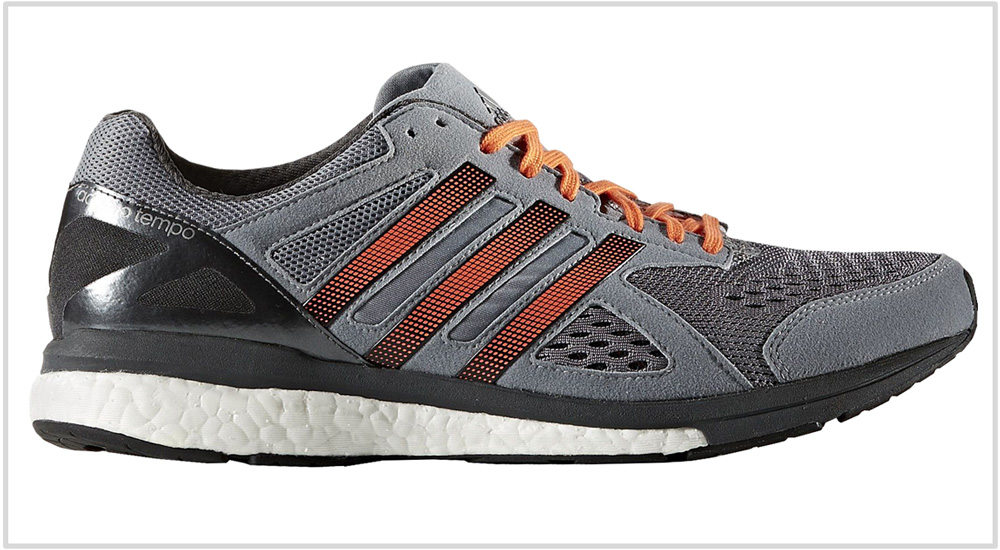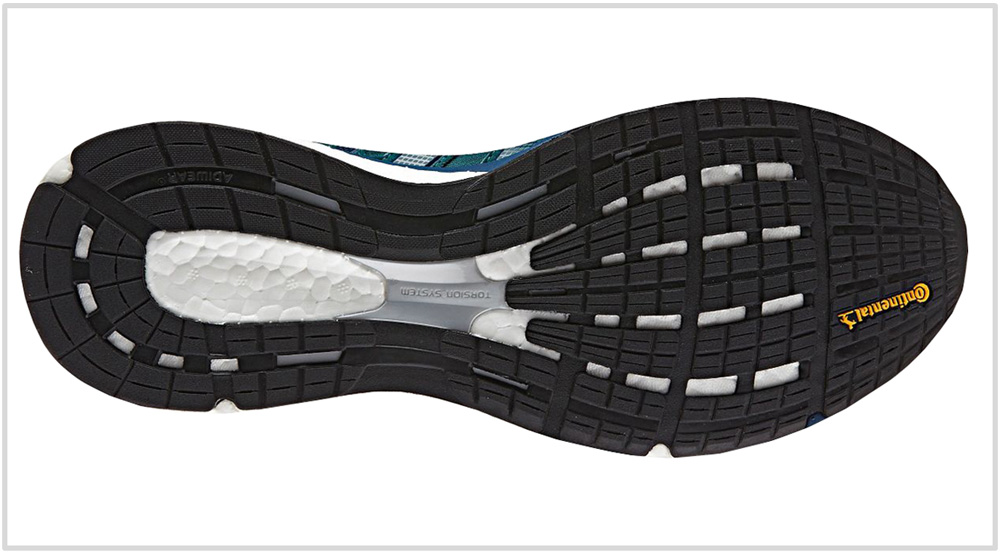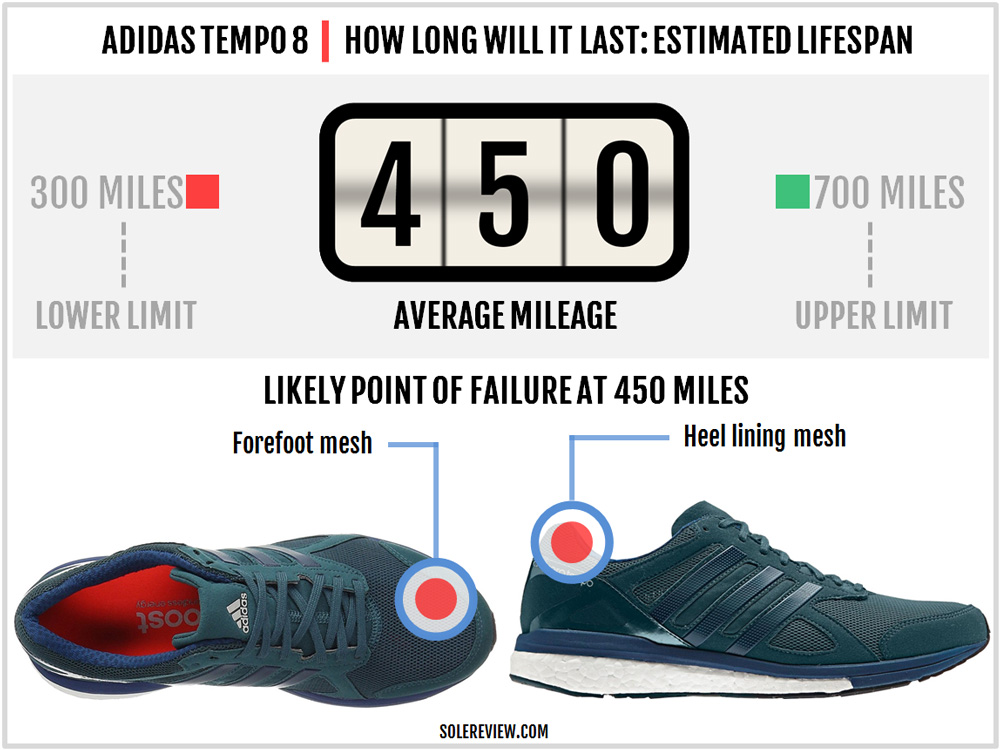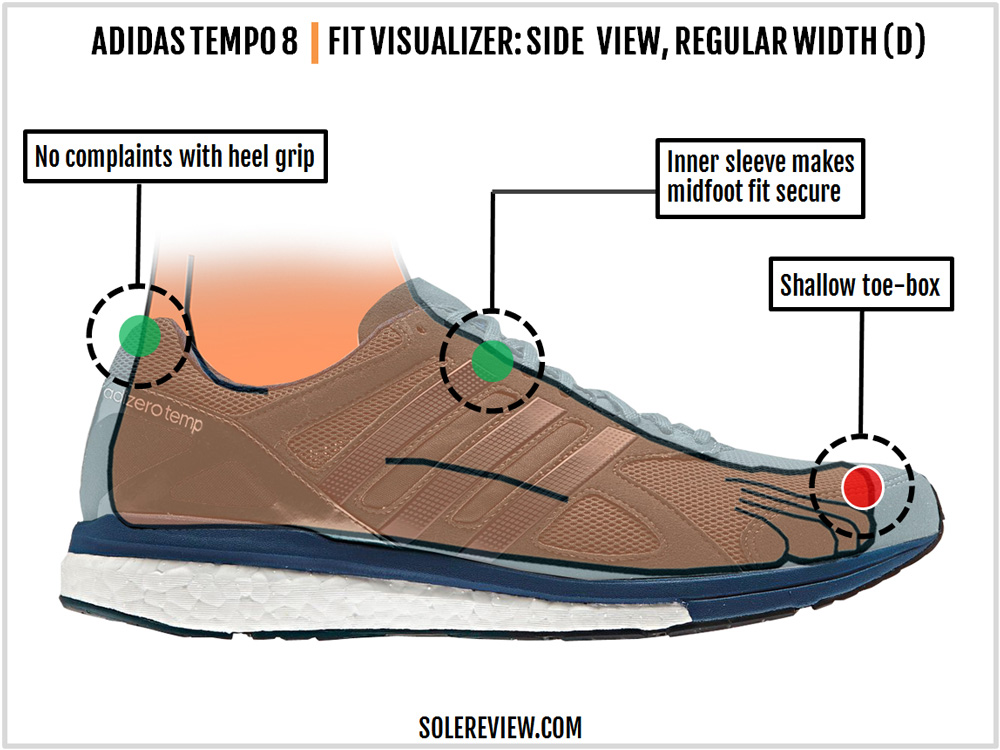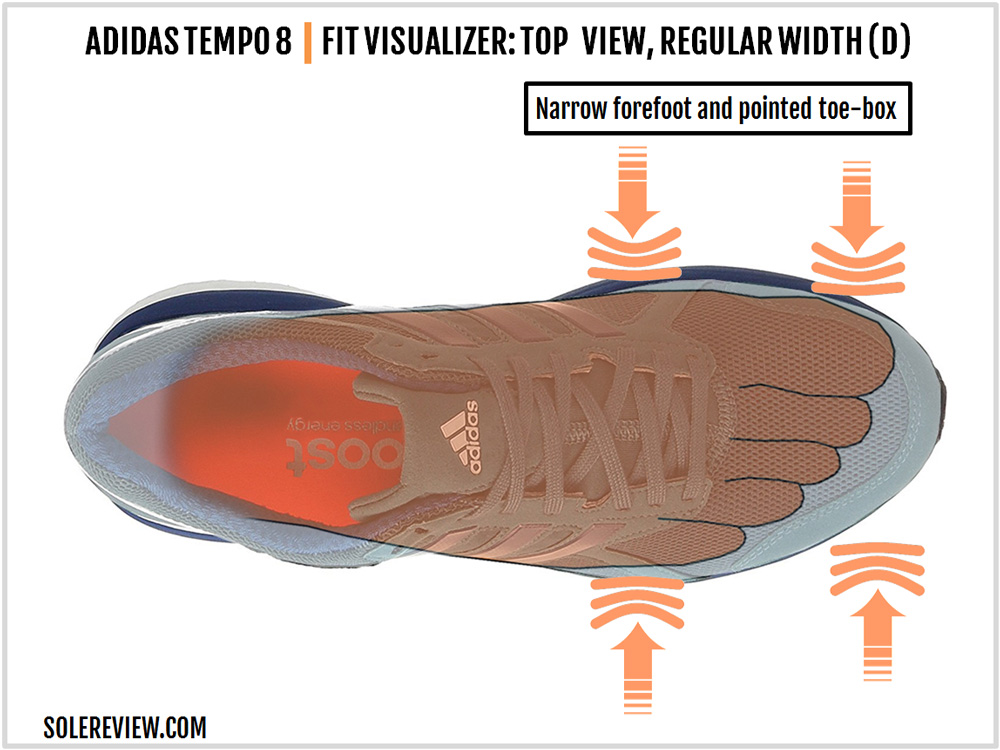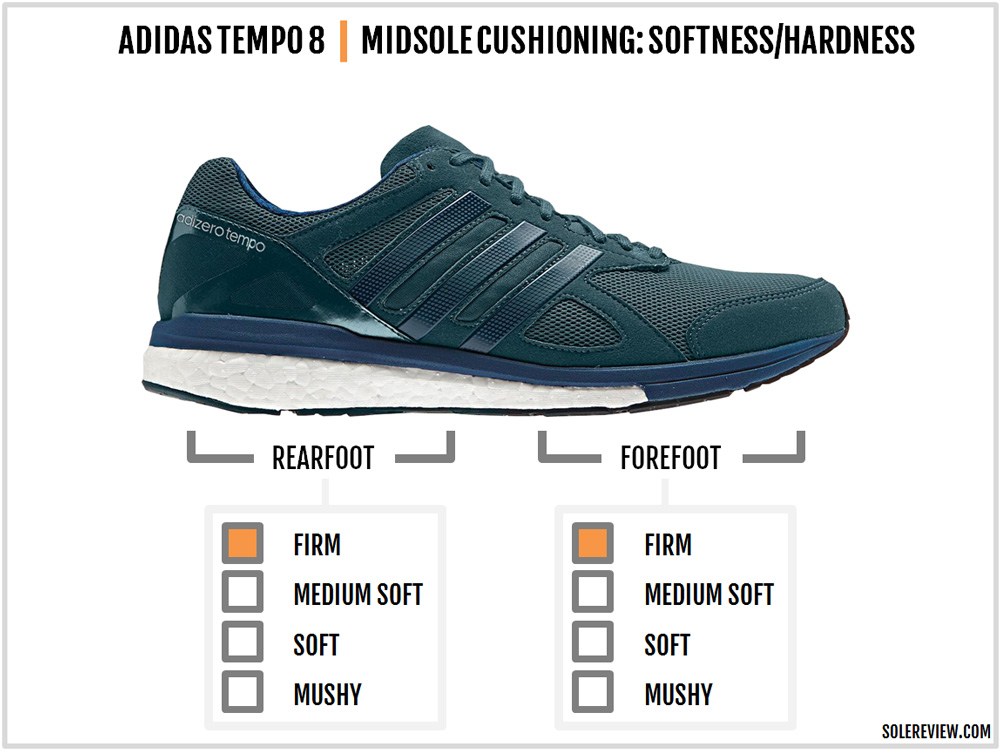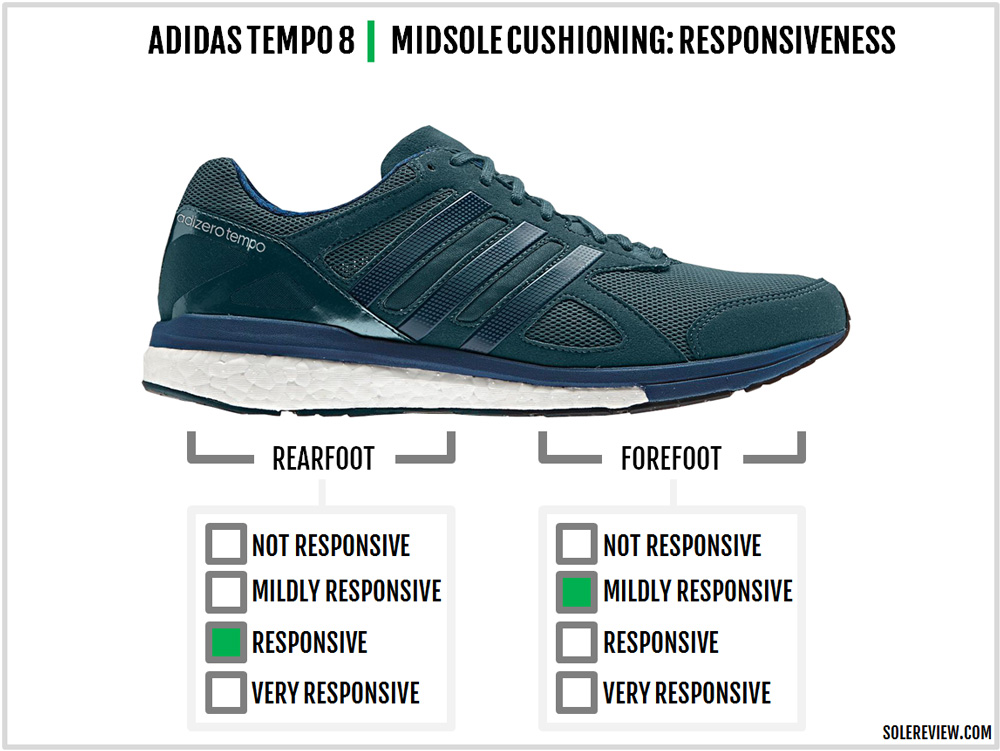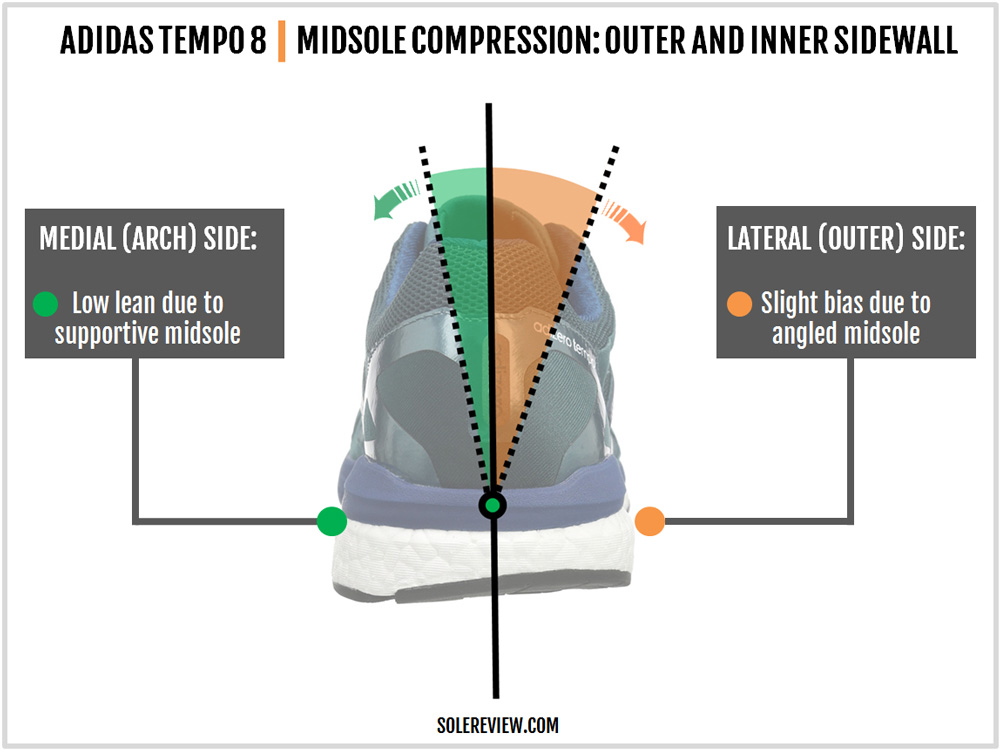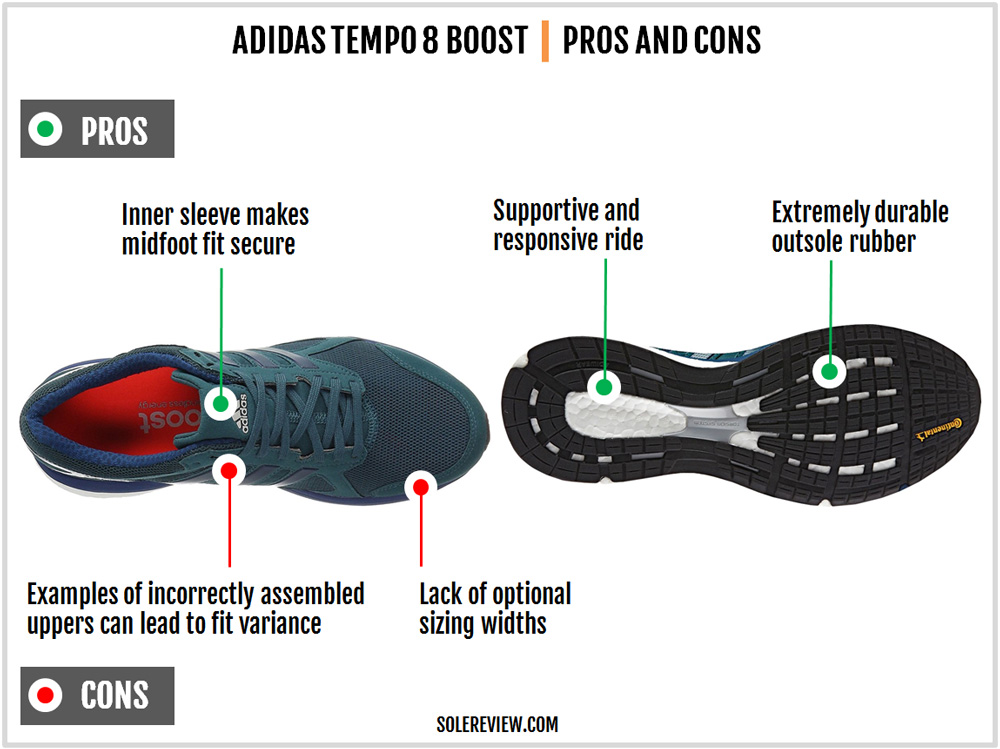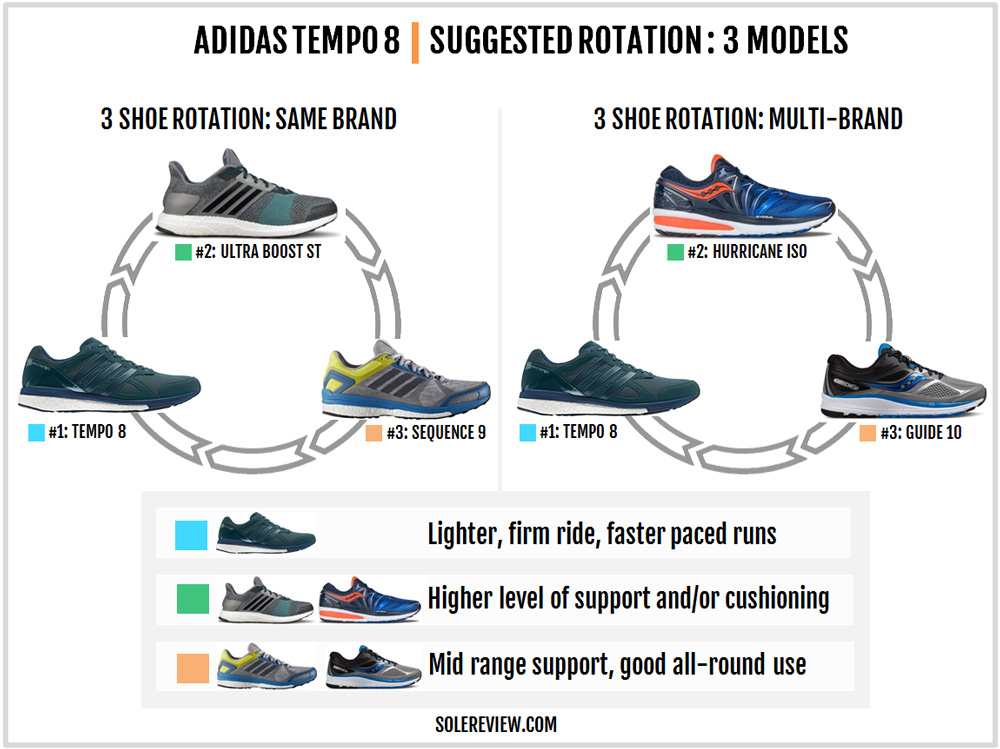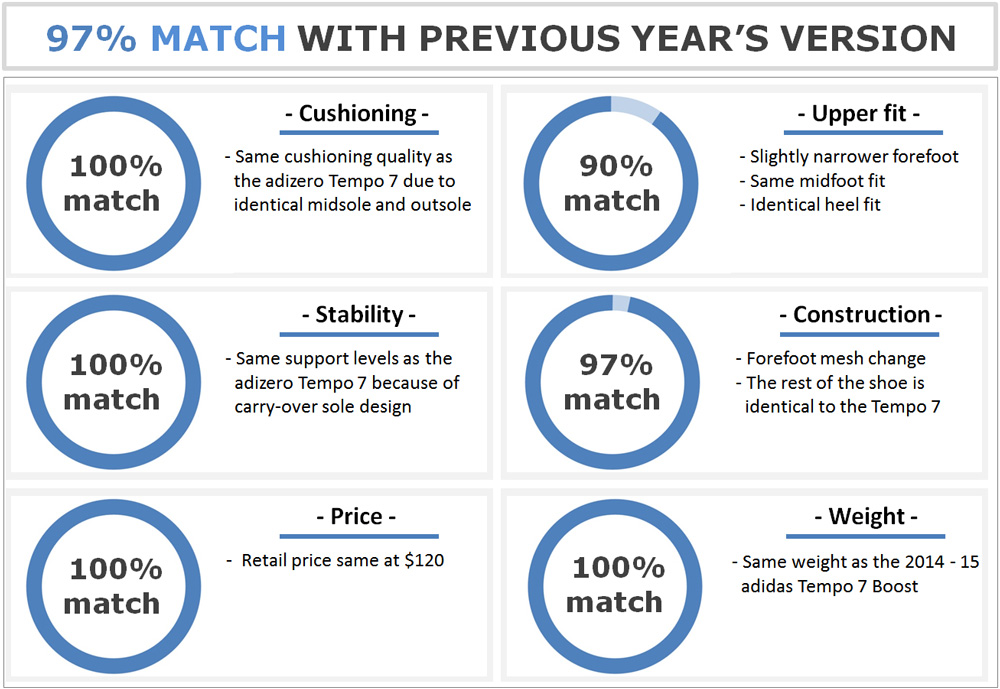INTRODUCTION
Ok, let’s get the headlines out of the way first. The Tempo 8 is nothing but the Tempo 7 with an updated forefoot mesh. The new forefoot changes the fit ever so slightly, but that’s it. Nothing else to report if you’ve already familiar with how the Tempo 7 fits and feels.
But only if everything was so simple. The Tempo 8 Boost is currently available in three variants; two of which are the result of a mid-season product update, and the another which is a gender specific release.
The first release for the TB8 uses a regular spacer mesh for its forefoot. The spacer mesh based Tempo 8 is the subject of this review, and also the one which is currently available.
Mid-season updates have become de rigueur for adidas. Remember the Supernova Glide 8’s mid-year switch to a different outsole design? Well, the Tempo 8 doesn’t get as drastic a change as an outsole switch, but receives an engineered mesh forefoot instead of a spacer mesh construction.
Functionally, this implies that the toe-box and forefoot come with open and vented areas, as opposed to the uniformly dense knit of the spacer mesh.
The third version of the Tempo Boost 8 happens to be gender specific. Of late, adidas is marketing running shoes targeted at female runners; like the Pure Boost X with its strange under-arch design for instance.
The women’s Tempo 8 has a visually cleaner upper which relies on no-sew methods instead of cut-and-stitch layers. The women’s adizero Tempo 8 has a cleaned up forefoot with an internal toe-bumper which increases toe-box room. The midfoot has a net-mesh layer over the three stripe logo, and the tongue comes without a sleeve.
Looking at the visually distinct toe-box profile, there is a faint possibility that the women’s model uses a slightly different last, but we can’t confirm it. The women’s TB8 shares the same midsole as the men’s Tempo 8, Stableframe and all that. In short, the women’s Tempo is an upper-only variant.
What the Tempo 8 is for adidas, the asics ds trainer 21 is for Asics, and the 1500 V2 for New Balance. These are lightweight models intended for fast training, placed one rung above the all-out racing flat category from a cushioning perspective.
What’s unique about these shoes is that most of them integrate a support feature into the medial midsole. Depending on the brand, there’s a different interpretation of what that support feature is. On the adidas, it is the Stableframe midsole sans the medial post; the DS Trainer and 1500 use small, yet visually distinctive medial posts.
On the Brooks Asteria, the firmer component wraps around the heel section, and ends up in a triangle shaped wedge on the medial side. Saucony uses a regular medial post under the midfoot on its Fastwitch 7, and the Mizuno Catalyst does its own thing with a variation of the Wave plate.
Most of the models mentioned have a medial post so small, it’s barely noticeable. So if you’re shying away from these models because of a medial-post, then don’t. This is precisely the reason why we’ve recommended the adidas Boston 6 too.
The Boston might not have a ‘support’ design feature like the Stableframe, but it has a cushioned yet supportive ride. The same truism applies for the adidas Tempo Boost 8 too. It lacks a medial post in the traditional sense; in fact, the heel has exposed Boost on either side.
DESIGN AND MATERIALS
Compared to the Tempo 7, the upper design hasn’t changed at all except for the new forefoot mesh. Now depending on which version of the Tempo 8 you land up with, the mesh could be either a regular spacer or an engineered mesh.
The spacer mesh has a one-dimensional design with no variation over its surface. On the other hand, if the engineered mesh Tempo is what you have, then you’ll get a vented forefoot top and sides, and a denser weave over the rest of the surface. The rearfoot of both the Tempo 8 versions get the spacer mesh, just like the Tempo 7.
If you aren’t familiar with the outgoing Tempo 7’s design, we’ll give you a quick tour of the Tempo 8’s design, which is identical to the TB7.
Besides the spacer and/or engineered mesh, the TB8 uses a lot of synthetic suede leather. Except for the heel counter where there’s a fused overlay, all the components are stitched the old-school way.
Both the adios 3 and the Tempo Boost 8 are a visual throwback to vintage adidas shoes like the adidas Marathon trainer, where the upper was genuine suede over double-knit polyester mesh.
Inside, the tongue is attached to an inner sleeve. That similarity with many other sleeved models aside, the Tempo 8’s approach is slightly different. The tongue is split down the center, which means that the tongue is an integral part of the sleeve. There are no side-seams attaching the tongue to the sleeve; only a solitary flat-lock seam runs down the tongue.
This doesn’t mean that the insides have a 100% smooth surface. The adidas three-stripes logos outside lead to stitch lines running over the sleeve. Then there’s another flat-lock seam attaching the engineered or spacer mesh (of the forefoot) to the inner sleeve.
The heel collar has sparse padding as befits a lightweight trainer. The heel is molded narrow with an internal heel counter, and contains the only external clue which can tell a Tempo 8 Boost apart from the Tempo 7.
On the outside, the heel counter has an ‘adizero tempo’ callout, whereas on the Tempo 7 it says ‘tempo boost.’ But this is easy to miss even to a trained eye, and adidas should start numbering their shoe models to match the official description.
The lack of shoe nomenclature is a problem with the Glide Boost too, where the two consecutive models are virtually indistinguishable from one another.
The outsole is built using a Continental + adiwear rubber combo which is identical to the Tempo 7. The outsole is mostly covered except for the under-heel area and thin slits under the forefoot, where there’s exposed Boost foam. There’s a plastic Torsion shank under the midfoot which also extends to support the inner rearfoot.
Mated to the Tempo 8’s outsole is a part Boost, part EVA midsole. Two of adidas’s support shoes – the Sequence 9 and the Tempo 8 – feature the ‘Stableframe’ midsole design. The rearfoot area is free of a medial post; instead, the forefoot has a sidewall made of solid EVA.
The forefoot support approach is clearly a departure from how most brands treat this shoe category.
Regardless of the walled-up forefoot, the Boost layer between the upper and the outsole extends from heel to toe. Under the forefoot, the sidewall might be firm, but the core is Boost foam. There’s a cut-out in the fabric lasting which gives foot direct access to the Boost midsole below.
The rest of the midsole (save the forefoot) has the firmer EVA lying atop the Boost foam. Like the Tempo 7, the insole is made of compression molded EVA foam a few millimeters thick.
By the way, the insole has the second clue to identifying the Tempo 8 from the 7. Instead of the ‘adizero’ text branding, the insole now says ‘Boost.’
The sole unit is carried over from the Tempo 7 in its entirety. That makes the Tempo 8 the only 2016 adidas Boost shoe to feature the legacy Continental rubber outsole. The durability of this design has been legendary, with many runners reporting over 700+ miles of trouble-free use.
At one time, most adidas shoes had this design. Recently, adidas has changed the outsole design, transitioning to a flat-lugged layout with un-tested durability. Since the TB8 retains the first generation outsole design, there is no cause for worry.
The Tempo 8’s upper is well put together, with supple synthetic suede leather over a mesh and sleeve construction. It is unlikely that an upper part will fail suddenly. Over time, the toe-box mesh has the highest probability of tearing after a few hundred miles.
The toe-box is pointed and slightly shallow, with the big-toe in contact the forefoot mesh. Depending the foot anatomy, running style and kind of workout, it is likely that the friction between the mesh and the big-toe will lead to gradual wear and tear of this area.
UPPER FIT AND FEEL
There’s little change in the toe-box dimensions. In other words, it’s shallow with the mesh in contact with the big-toe. Going half a size up will ease things, but only so much.
The inner sleeve wraps around the foot securely. It’s a true sleeve and not a narrow gusset or a band, so the fit spread is uniform instead of localized. The heel collar doesn’t have a great deal of padding, but then shoes such as the adios, Boston and the Tempo have a utilitarian nature.
Either way, the heel with its internal counter will give you no reason for complaint.
The pointy shape of the toe-box carries over from the 7. The front of the shoe will crunch your toes together in a racing-flat fashion; this fit property will necessitate going a half-size up over other adidas such as the Glide and Sequence.
Changing the Tempo 7’s forefoot mesh also affects the upper fit. Since the Tempo 8’s spacer mesh is slightly thicker than the thinner fabric of the 7, there’s a small reduction in space. Even if we’re talking about the plump engineered mesh, it should have an equal impact on the fit.
RIDE QUALITY AND BEHAVIOR
Like the Sequence 9, the Tempo 8 has a firm EVA sheet over the Boost midsole. The forefoot has an open window, but the thin midsole stack produces responsiveness but little softness. The EVA layer over the rest of the midsole turns the ride unmistakably firm.
The compression molded foam insole does a fine job of creating the first layer of softness immediately under the foot. The sockliner delivers a sensation of superficial cushioning just under the foot, but if you’re looking for more cushioning responsiveness, then you have to run faster to tap into the reserves.
Will the TB8 work as a long distance shoe? Things should go swimmingly till 10 miles, and after that, your cushioning tolerance will kick in. If you’re used to racing flat nothingness, then the Tempo’s cushioning will go the marathon distance. If not, then look for alternatives as outlined in our ‘rotation’ breakout.
A caveat holds true for most low-stacked adidas Boost shoes such as the adios, Boston and the Tempo. The midsole delivers increased spring-back action at higher paces than crawl speeds. The underlying principle here is rather simple.
In the upper reaches of the midsole, you have the softer insole, followed by the firmer EVA Stableframe. So you need to apply enough pressure which causes the Boost foam to compress and then return to its original position. The loading threshold kicks in when you pick up running pace, which produces a succession of piston-like movements over the Boost foam.
There’s also an under heel cavity with exposed Boost which produces responsive cushioning due to a trampoline-like effect, but again, that happens at higher running speeds.
At lower speeds, none of this happens. All you’ll get is compression from the molded sockliner, and a minor amount of Boost cushioning.
Forefoot strikers will also benefit from the Boost midsole’s responsive qualities. The cut-out under the forefoot gives you direct access to Boost, and during faster workouts – say during the quick touch-and-go movements of track training – the midsole will produce noticeable rebound.
The Stableframe midsole used on the TB8 does not use a medial post. In fact, both sides of the heel have exposed Boost foam, and the Stableframe EVA sidewall only begins after the midsole. Combine this design with an under-heel cavity, and you end up with a very supportive rearfoot. There a conspicuous lack of aggressive lateral bias or compression which is common to many shoes in this category.
The forefoot has firm EVA midsole sidewalls on both sides, and an exposed internal window allows the foot to tap into a soft Boost core. So yes, the TB8 has excellent support levels, be it the rear or front. The minor amount of heel bias is within tolerance limits.
Using a consistent material set-up from heel-to-toe ensures smooth transitions. The Boost tapering from thick to thin help spread the cushioning gradually, unlike some shoes where most of the cushioning is loaded under the heel.
The overall midsole stack is in a sweet spot between a regular trainer and a racing flat, so there’s enough cushioning without sacrificing ground feel. adidas’ marketing description for the Tempo 8 couldn’t be more accurate.
PROS AND CONS
The Tempo Boost 8 scores well in most areas, with no glaring design flaws worth pointing out. The ride feels fast while being cushioned and supportive, and there are quality materials all around. The narrow upper uses a sleeve which produces a relatively smooth fitting interior. That said, it would have been nice to have optional widths in case one wished for additional upper room.
Solereview had a bad experience with the Tempo 7 because of severe upper alignment issues. Given its identical upper, there are chances that the Tempo 8 will suffer from the same misfitting issues of the TB7, so be careful when you buy. Even during our purchase of the adios 3 Boost, solereview struggled to select a properly finished shoe at the local adidas store.
The quality check isn’t possible while buying online. But if you experience a fit difference between the left and right shoe, then know that it isn’t your imagination working overtime. It is likely a pair of a misaligned Tempo Boost at work.
This is wishful thinking, but can a thicker spacer or engineered mesh help in better placement of stitched components over the TB8? We’ll update this section as we receive more crowdsourced reader reviews.
RECOMMENDED ROTATION
In the Tempo 8’s case, both the rotation and upgrade charts for adidas are going to look the same. The TB8 is perfectly paired up with the Sequence 9, a shoe with more upper room and cushioning.
Since the TB8 is purpose-built for fast runs, it doesn’t make sense to view the Sequence 9 – or for that matter, the soft Ultra Boost ST as ‘upgrades’. Their role is better suited for rotational companions alongside the Tempo Boost 8 rather than straightforward ‘upgrades’.
A more cushioned Tempo – in other words the Sequence – isn’t a fast shoe upgrade, but a completely different product. So for this review, we’ll skip the upgrade infographic because of its contextual irrelevance.
Saucony and adidas shoes have a shared ride character because of the same materials used in the midsole. For all practical purposes, Saucony’s Everun is nothing more than a sliced-and-diced version of the adidas Boost.
Except for the Saucony Freedom, none of the other Saucony models use a full-length Everun midsole. Understandably, while Everun won’t feel the same as Boost, you’re bound to notice functional similarities.
In that context, the more cushioned Hurricane ISO 2 makes the logical other-brand alternative when it comes to increased cushioning and support over the Tempo 8. And filling in for the Sequence 9 is the Saucony Guide 10, a support shoe with a topsole-only Everun layer.
SUMMARY
Not a lot to discuss here, because there are hardly any changes. There is more difference between the two versions of the 2016 Tempo 8 Boost than there is between the Tempo 7 and the spacer mesh TB8.
The only change is the forefoot mesh, which leads to a minor fit change. The $120 retail price hasn’t changed, nor has the weight. This applies only to the men’s Tempo 8; there are many upper design updates on the women’s Tempo 8 model.

